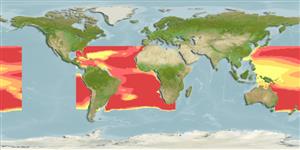Teleostei (teleosts) >
Argentiniformes (Marine smelts) >
Opisthoproctidae (Barreleyes or spookfishes)
Etymology: Rhynchohyalus: Greek, rhingchos = snout + Greek, hyalos, ou = glass (Ref. 45335).
Environment: milieu / climate zone / depth range / distribution range
Ecology
Marine; pelagic-oceanic; depth range ? - 775 m (Ref. 86942). Tropical; 35°N - 49°S, 89°W - 154°W
Eastern Atlantic: Madeira and off Cape Town, South Africa (Ref. 6597). Western Atlantic: in tropical waters. Western Pacific: off the Ogasawara Islands (Ref. 559), Australia (Ref. 7300), and New Zealand (Ref. 5755). Reported from the Hawaiian Islands (Ref. 58302).
Size / Weight / Age
Maturity: Lm ? range ? - ? cm
Max length : 16.0 cm SL male/unsexed; (Ref. 6542)
Dorsal spines (total): 0; Dorsal soft rays (total): 10 - 12; Anal spines: 0; Anal soft rays: 7 - 10. Scattered melanophores ventrally; pelvic fins and area around anus black; head translucent (Ref. 6597). Body compressed. Brown in preserved specimen, with black pigment cells scattered in lower half (Ref. 37473).
Mesopelagic (Ref. 58302). Eggs and larvae are pelagic. Does not exhibit diurnal vertical migration (Ref. 6686).
Life cycle and mating behavior
Maturity | Reproduction | Spawning | Eggs | Fecundity | Larvae
Quéro, J.-C., 1990. Opisthroproctidae. p. 241-243. In J.C. Quero, J.C. Hureau, C. Karrer, A. Post and L. Saldanha (eds.) Check-list of the fishes of the eastern tropical Atlantic (CLOFETA). JNICT, Lisbon; SEI, Paris; and UNESCO, Paris. Vol. 1. (Ref. 6542)
IUCN Red List Status (Ref. 130435: Version 2024-2)
Threat to humans
Harmless
Human uses
Tools
Special reports
Download XML
Internet sources
Estimates based on models
Preferred temperature (Ref.
123201): 12.4 - 23.5, mean 17.8 °C (based on 262 cells).
Phylogenetic diversity index (Ref.
82804): PD
50 = 1.0000 [Uniqueness, from 0.5 = low to 2.0 = high].
Bayesian length-weight: a=0.02239 (0.00864 - 0.05802), b=2.98 (2.75 - 3.21), in cm total length, based on LWR estimates for this (Sub)family-body shape (Ref.
93245).
Trophic level (Ref.
69278): 3.7 ±0.1 se; based on size and trophs of closest relatives
Resilience (Ref.
120179): Medium, minimum population doubling time 1.4 - 4.4 years (Preliminary K or Fecundity.).
Fishing Vulnerability (Ref.
59153): Low vulnerability (10 of 100).
